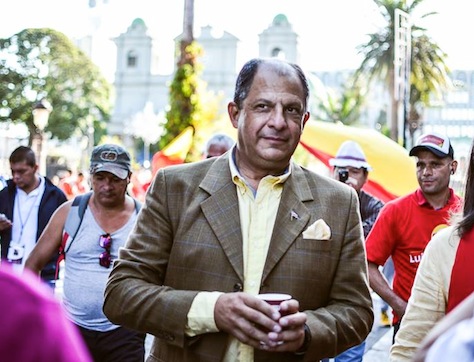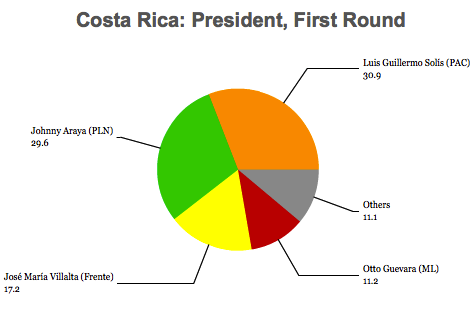Before yesterday’s presidential election, polls showed Luis Guillermo Solís, an academic and former diplomat, in fourth place in the race to become Costa Rica’s next president. ![]()
But on the strength of a surge in momentum at the end of the campaign, Solís (pictured above) not only elbowed his way into an expected April 6 runoff (only the second such runoff in the country’s history), but leapfrogged all the way to the top spot, edging out the frontrunner, San José mayor Johnny Araya, and the younger, more populist leftist José María Villalta. More recent surveys indicated a definite upswing in support as Solís capitalized on a strong performance in the final presidential debate, but even a late January poll showed Solís behind Araya, Villata and a conservative candidate, Otto Guevara.
Solís ultimately outpolled Araya by a little over 1% of the vote as undecided voters appear to have lined up solidly for the former diplomat — and he even defeated Araya in San José municipality, despite the fact that Araya has served as the city’s mayor since 1998.
So what happened?
It was clear going into Sunday’s election that Solís had the momentum, but no one thought he would pull off such a strong result. If you’re looking for a narrative, you could do worse to say that many Costa Rican voters found in Araya an untrustworthy leader with a mediocre record as the mayor of the country’s capital and the candidate of the ruling center-left Partido Liberación Nacional (PLN, National Liberation Party). Outgoing president Laura Chinchilla’s massive unpopularity dragged Araya’s campaign even lower. After eight years under PLN rule, Araya would have already faced a challenge to win an unprecedented third consecutive presidential term for the PLN. Given the anxiety of Costa Ricans over corruption, rising crime rates and the galloping rise in the country’s public debt, it’s not surprising that Araya fell short of a victory — and well short of the 40% he would have needed to win a first-round victory.
With the implosion of Costa Rica’s previously dominant center-right party, the Partido de Unidad Socialcristiana (PUSC, Social Christian Unity Party), Costa Ricans might have turned to Otto Guevara, the leader of the free-market liberal Movimiento Libertario (ML, Libertarian Movement), who was making his fourth consecutive presidential run. But though Guevera won 20% of the vote in the previous election in 2010, Costa Ricans seemed to want to turn to the left, not to the right, especially given the neoliberal policies that both the PLN and the PUSC have pursued over the past three decades. Though there may have been a path for a center-right candidate to make a breakthrough in the 2014 election, Guevara, whose ‘libertarian’ campaign heavily featured socially conservative positions on same-sex marriage and abortion, was not it.
Instead, by the end of 2013, many voters were supporting Villalta, the 36-year-old candidate, and sole legislator, of the Frente Amplio (Broad Front), a new socialist / social democratic party. But voters had doubts about Villalta, a champion of human rights, environmentalism and stridently left-wing politics. Despite Costa Rica’s moderate politics, Villalta proudly defended the late Venezuelan president Hugo Chávez and more radical socialist policies. If voters were already worried about Villalta’s youth and relative inexperience, they were certainly even more worried that Villalta espoused the kind of populist leftism of Venezuela, Bolivia and other socialist governments throughout Latin America, not the more moderate brand of leftism that’s had success in Brazil, Chile and elsewhere.
Enter Solís, the candidate of the Partido Acción Ciudadana (PAC, Citizen’s Action Party), a social democratic party founded in 2000 as an anti-corruption alternative to the PLN.
Solís launched relentless attacks on Araya and Chinchilla throughout the campaign, giving voice to the frustrations that many Costa Ricans shared. An academic, former ambassador to Panamá, and a former adviser to president Óscar Arias in the 1980s on the Esquipulas Peace Agreement, Solís left the PLN in 2005 over a dispute concerning internal party politics and Arias’s ultimately successful comeback bid to the presidency in 2006. Although Solís has never held elective office, voters found in him a candidate with enough experience in public life to entrust the presidency to him (unlike Villalta), a proponent of good government (unlike Araya) and a critic of the PUSC/PLN consensus on economic policy (unlike Guevara). Most importantly, voters found in Solís a leftist alternative to Araya who wouldn’t represent the kind a historical turn to the socialist chavista leftism that Villalta would have represented. Solís, with a more modest agenda of improving the Costa Rican health care and pension systems, represents just enough rupture from the PLN to deliver a new perspective on government without necessarily delivering Costa Rica into the far-left Venezuelan-led Alianza Bolivariana (Bolivarian Alliance).
Moreover, voters have had more time to get used to the PAC — its founder Ottón Solís ran strong campaigns in the three previous presidential elections, nearly defeating Arias in the 2006 race and placing second to Chinchilla, then riding a wave of optimism as Costa Rica’s first female president, in 2010. Since 2006, the Citizen’s Action Party has held more seats in the 57-member unicameral Asamblea Legislativa (Legislative Assembly) than any other opposition party. That’s a marked contrast to the Broad Front, whose sole representative in the prior Legislative Assembly was Villalta.
Though polls failed to show the last-minute Solís surge, they show that he is heavily favored to defeat Araya in a runoff, and he will be a much stronger challenger to Araya than Villalta. A University of Costa Rica poll from last week showed that Araya would defeat Villalta in a runoff by a margin of 39.5% to 35.9%. But Solís led Araya by a whopping margin of 46.8% to 29.4%, with just 23.9% undecided.
Many of Villalta’s supporters will almost certainly rally around Solís, which would bring Solís very close to reaching an absolute majority. Guevera’s supporters, despite their social and economic conservatism, may not enthusiastically flock to Araya, given the fatigue with the PLN’s time in power and corruption allegations.
The PUSC’s candidate, Rodolfo Piza, who replaced the previous nominee, Rodolfo Hernández, who dropped out of the race in October. Despite a relatively hopeless cause, Piza won 6.0% of the vote — a poor result, but still better than the PUSC’s candidates in 2006 and 2010.
In the legislative election, preliminary results show a fractured Legislative Assembly: Liberation will hold 18 seats (a six-seat drop), Solís’s PAC will hold 14 (three-seat gain), Broad Front will hold nine (eight-seat gain), PUSC will hold eight (three-seat gain) and Guevara’s ML will hold just three (six-seat drop). Four other small parties will collectively hold five seats.
Generally speaking, the parliamentary results show a remarkable shift leftward — the PAC and Broad Front have gained 11 seats in a 57-member chamber. But no matter who wins the runoff, Costa Rica’s next president will have to build a broad cross-party coalition. Solís’s PAC and the Broad Front are just two seats short of a majority. A coalition of Araya’s PLN, the Libertarian Movement and PUSC would hold a one-seat majority.

